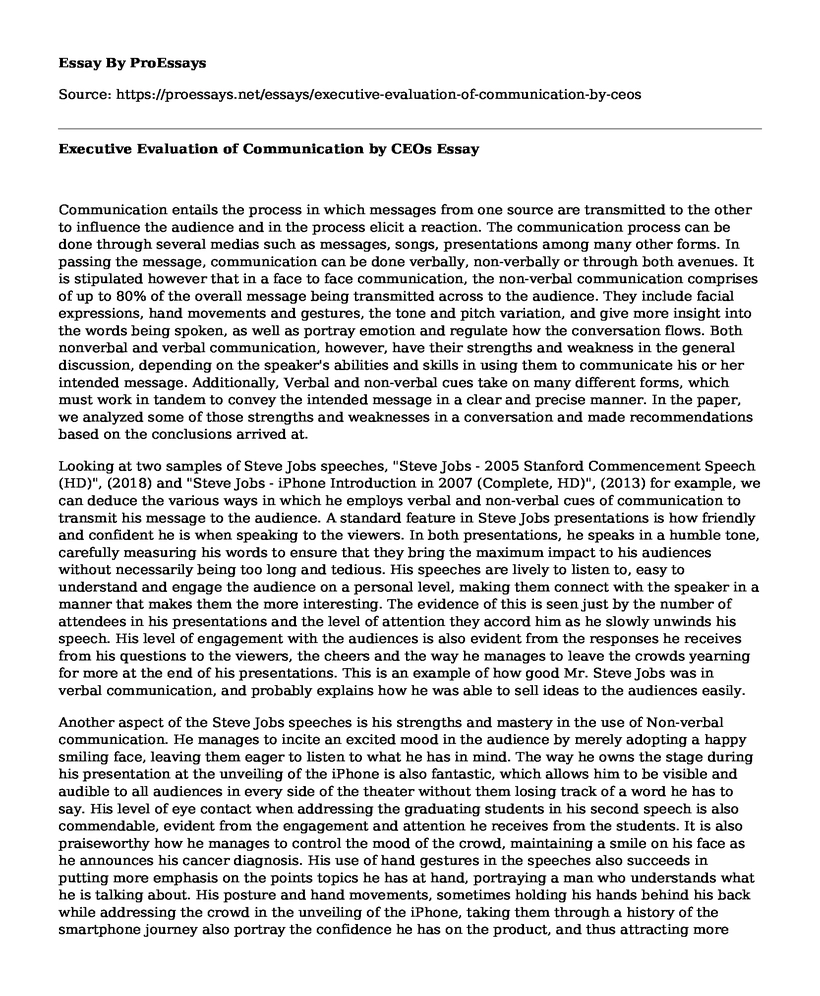Communication entails the process in which messages from one source are transmitted to the other to influence the audience and in the process elicit a reaction. The communication process can be done through several medias such as messages, songs, presentations among many other forms. In passing the message, communication can be done verbally, non-verbally or through both avenues. It is stipulated however that in a face to face communication, the non-verbal communication comprises of up to 80% of the overall message being transmitted across to the audience. They include facial expressions, hand movements and gestures, the tone and pitch variation, and give more insight into the words being spoken, as well as portray emotion and regulate how the conversation flows. Both nonverbal and verbal communication, however, have their strengths and weakness in the general discussion, depending on the speaker's abilities and skills in using them to communicate his or her intended message. Additionally, Verbal and non-verbal cues take on many different forms, which must work in tandem to convey the intended message in a clear and precise manner. In the paper, we analyzed some of those strengths and weaknesses in a conversation and made recommendations based on the conclusions arrived at.
Looking at two samples of Steve Jobs speeches, "Steve Jobs - 2005 Stanford Commencement Speech (HD)", (2018) and "Steve Jobs - iPhone Introduction in 2007 (Complete, HD)", (2013) for example, we can deduce the various ways in which he employs verbal and non-verbal cues of communication to transmit his message to the audience. A standard feature in Steve Jobs presentations is how friendly and confident he is when speaking to the viewers. In both presentations, he speaks in a humble tone, carefully measuring his words to ensure that they bring the maximum impact to his audiences without necessarily being too long and tedious. His speeches are lively to listen to, easy to understand and engage the audience on a personal level, making them connect with the speaker in a manner that makes them the more interesting. The evidence of this is seen just by the number of attendees in his presentations and the level of attention they accord him as he slowly unwinds his speech. His level of engagement with the audiences is also evident from the responses he receives from his questions to the viewers, the cheers and the way he manages to leave the crowds yearning for more at the end of his presentations. This is an example of how good Mr. Steve Jobs was in verbal communication, and probably explains how he was able to sell ideas to the audiences easily.
Another aspect of the Steve Jobs speeches is his strengths and mastery in the use of Non-verbal communication. He manages to incite an excited mood in the audience by merely adopting a happy smiling face, leaving them eager to listen to what he has in mind. The way he owns the stage during his presentation at the unveiling of the iPhone is also fantastic, which allows him to be visible and audible to all audiences in every side of the theater without them losing track of a word he has to say. His level of eye contact when addressing the graduating students in his second speech is also commendable, evident from the engagement and attention he receives from the students. It is also praiseworthy how he manages to control the mood of the crowd, maintaining a smile on his face as he announces his cancer diagnosis. His use of hand gestures in the speeches also succeeds in putting more emphasis on the points topics he has at hand, portraying a man who understands what he is talking about. His posture and hand movements, sometimes holding his hands behind his back while addressing the crowd in the unveiling of the iPhone, taking them through a history of the smartphone journey also portray the confidence he has on the product, and thus attracting more audience attention, and give them a reason to believe in his iPhone.
Though Mr. Jobs exudes a lot of skills in communicating to an audience, there are a few fields he could improve in to give his speeches more impact. In both cases we analyzed, Mr. Jobs rarely asked the audience for their feedbacks, instead of explaining himself most of the time. Giving them a chance to express their views would greatly help the speaker to determine more precisely the direction of the speech. Secondly, while addressing the students in the second speech, his eye contact with the audience is limited as he reads through most of his speech, only occasionally looking up at them. In this area, I would recommend that he improves his eye contact with the listeners as this would make his speech appear more realistic and engaging, encouraging them to concentrate more. Finally, in the same address, he rarely employs facial expressions to reinforce his speech. Adopting this technique more would improve his portrayal and elicit of emotional response for his speech with the audience.
References
N2TechGeeks. (2013). [HD] Steve Jobs - iPhone Introduction in 2007 (Complete). Retrieved from https://www.youtube.com/watch?v=9hUIxyE2Ns8
Steve Jobs - 2005 Stanford Commencement Speech (HD). (2018). Retrieved from https://www.youtube.com/watch?v=yjcTKLYA3fE
Cite this page
Executive Evaluation of Communication by CEOs. (2022, May 26). Retrieved from https://proessays.net/essays/executive-evaluation-of-communication-by-ceos
If you are the original author of this essay and no longer wish to have it published on the ProEssays website, please click below to request its removal:
- Essay Example: Marketing Plan and Sales Strategies
- How to Ensure HR Strategy Is in Alignment With Business Strategy Essay
- Technology Business Implications Essay Example
- Essay Example on Day-to-Day Decisions in Companies: Short & Long-Term Effects
- Traits of Frederick Douglass' Leadership Essay
- Essay Example on Career Choices in Security and Loss Prevention: Options and Outcomes
- Essay Example on Traditional Management: Exploring Red Ocean Strategy







